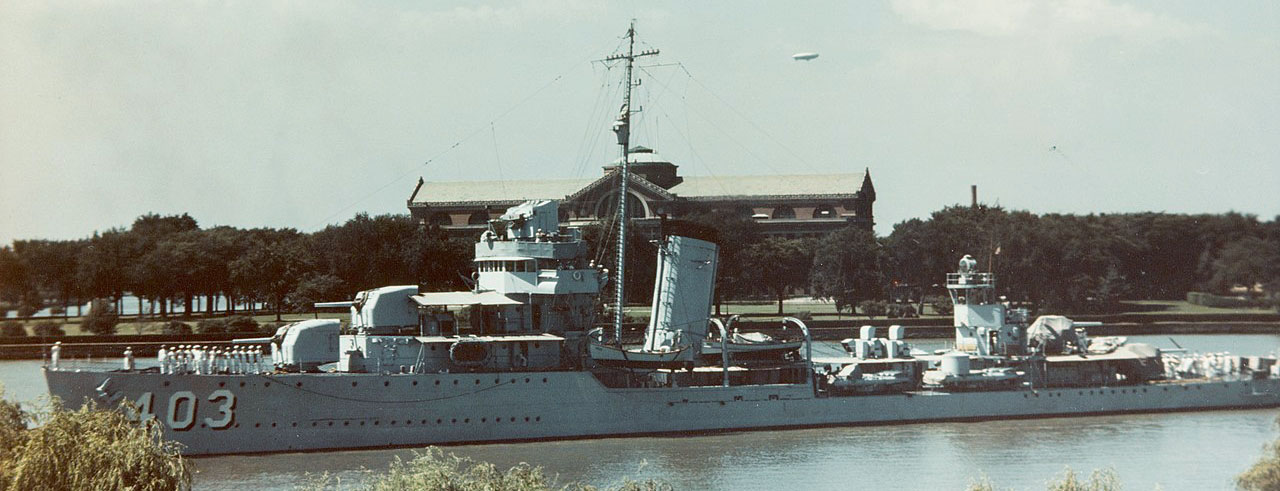
Benham class Destroyers (1938)
 US Navy Fleet Destroyers (1936-46):
US Navy Fleet Destroyers (1936-46):
USS Benham, Ellet, Lang, Mayrant, Trippe, Rhind, Rowan, Stack, Sterett, Wilson DD-397 to DD-408
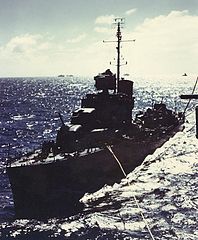 The Benham-class destroyers were essentiall a repeat of the previous Gridley-Bagley classes, sporting the same impressive sixteen torpedo battery and four main guns, single funnel. They shared the same hull and the only difference was essentially their third boilers arrangement instead of four, thanks to improvements in boiler output and heat performances, freeing space but they kept essentially the same speed and range. These ten ships (DD-397 to 408) served on both the Atlantic and Pacific, with Benham and Rowan sunk in action. Collectively they earned more than 91 battle stars.
The Benham-class destroyers were essentiall a repeat of the previous Gridley-Bagley classes, sporting the same impressive sixteen torpedo battery and four main guns, single funnel. They shared the same hull and the only difference was essentially their third boilers arrangement instead of four, thanks to improvements in boiler output and heat performances, freeing space but they kept essentially the same speed and range. These ten ships (DD-397 to 408) served on both the Atlantic and Pacific, with Benham and Rowan sunk in action. Collectively they earned more than 91 battle stars.

USS Rhind underway, September 1942
Design of the class

Broadside view of USS Mayrant (DD-402) on 25 October 1939
The ten Benhams (FY 1935 Program) were the last serie of three classes with similar characteristics, all laid down 1935-1937. The previous Gridley class (4 ships) and Bagley (8 ships) emerged from the need for a better torpedo armament to answer the Japanese “special type” destroyers, featuring a world-beating sixteen torpedo tubes battery in four quadruple banks. This was completed by a battery of four 5-inch (127 mm) 38 caliber dual purpose guns, usabled as anti-surface and anti-aircraft weapons. Distinctive with their single stack, the only difference of the Benhams compared to the Bagley-Gridleys was internal, with a new type of high pressure boilers for their machinery.
Designed by Gibbs & Cox naval architecture studio of New York, they sported a new type of high-pressure boiler, enabling a reduction from four to three boilers, compounded by a more efficient turbine arrangement, closer to the Mahan class ships. This was a difference from the Bagley class, a Navy design using the machinery of the long-range Mahan class, traduced by a prominent boiler uptake for their single stack. The Gridley class were final design was the product of the Bethlehem Shipbuilding Company, the engineering bureau of the naval yard. The advanced high-pressure boilers came from this yard but the turbines resembled those of the Farragut class, and thus, their range was limited to 6,500 nm like the previous Gridley-Bagleys. The following Sims class returned to a more sensible arrangement favouring artillery over torpedoes with five guns and two quad banks (instead of four), same speed and range. The wartime Bensons/Gleaves introduced quad torpedo tubes banks to compensate, while being larger, and the Fletchers essentially improved on range.
Hull and general design
The Benham class essentially repeated the hull of the previous Gridley made for at the same Bethlehem Yard, the Gridleys being made at Norfolk, Boston and Mare Island in California. The Benhams were even distributed more largely, to six yards: Three at Federal, Kearny (Benham, Ellet, Lang), two at Boston Naval Yard (Mayrant, Trippe), one at Philadelphia (Rhind), two at Norfolk NyD (Rowan, Stack), one at Charleston (Sterett) and one on the West Coast, Mare Island NyD, USS Wilson.
They displaced 1,656 tons standard for 1,888 tons normal load and 2,250 tons full load. This was slightly more than the Bagleys; As for the hull, it was very close, at 340 ft 9 in (103.86 m) in lenght (like the Gidleys) for a 35 ft 6 in (10.82 m) beam (same) and a draught of 13 ft 3 in (4.04 m), slightly more.
The architecture was similar, with the now classic tall forecastle of the Farraguts, superfiring main guns, triangular shaped bridge with the main director mounted on top, mainmast, single stack, platforms for the light AA, and the four TT banks on the broadside, two either side, not staggered like the WWI Wickes-Clemsons. The two aft main guns were also in a superfiring position. These ships had two main utility yawls under davits between the bridge and funnel. The rest of the crew had at disposal four or more ready inflatable rafts, with more in crates. The forecastle was further elongated by side bulwarks for seakeeping. They had a radio aft, which wires were connected from the half-mast of the quarterdeck structure up to the mainmast. Like the Bagley-Gridley they suffered no overweight issues and stayed relatively stable, though less than the WW2 ships.
Powerplant
The Benhams showed the most advanced propulsion plant on any US destroyers. The centerpiece was their three Babcock & Wilcox boiler designs used, allowing to produced the same output with three rather than four boilers. This freed space, although it was not used for extra fuel bunkerage. Steam pressure for these rose from 400 psi (2,800 kPa) to 600 psi (4,100 kPa) the steam being superheated to 700 °F (371 °C) as in the Gridleys. This improved fuel economy, and was compounded by boiler economizers and the double reduction gearing of the turbines, which included the now standard cruising stage. Range figures are varying. Now it is believed to be less than the Gridleys at 5,390 nmi (9,980 km; 6,200 mi), versus 6,940 nmi (12,850 km; 7,990 mi) based on a fuel capacity which went from 504 down to 484 tons, a paradox given their freed space. The main turbines developed 49,250 shp (36,730 kW) on trials (lead destroyer). For all ships, they were manufactured by Westinghouse.
Armament
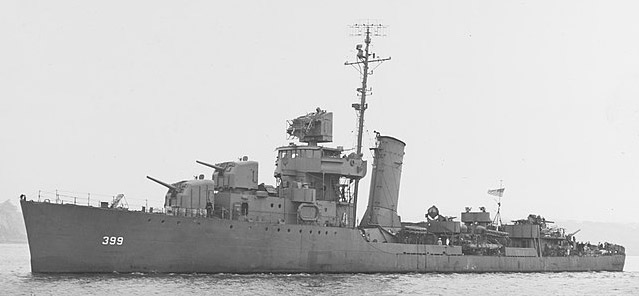
USS Land off Mare Island, October 1943
Main: 4x 5-in/38
The Benhams had exactly the same armament as the Gridleys-Bagleys: Four 5-inch/38 caliber dual purpose guns. They were in single Mark 12 mounts. The choice was made after the Mahans, to sacrifice one gun for additional torpedo tubes.
The 5-inch/38 guns adopted for the whole troika of destroyers featured the same all-angle power loading, and they were fast, director controlled, so top of the line for anti-aircraft defence at the time in 1939. By late 1942, the shells were assorted with radio proximity fuses and became even more effective. Unlike the previous class weher only the two forward 5-inch guns were in enclosed mounts, the rest open, the Benhams went for all four enclosed mounts, but of the Mark 30 Mod 1 base-ring types. They featured an integral ammunition hoist, fed from a handling room below. Less adavanced than the forward mounts, this still enabled during neutrality patrol to alternate between full enclosures or an open-top shield on the last two guns, depending of they served in Carribean-Azores waters to the north Atlantic in 1941. The shields were removed later to save weight and increased AA, leaving the mounts like those of previous classes.
In 1940-41 Neutrality Patrol also the aft torpedo tube mounts were landed to increase the Depth charge provision, between the two original racks and four K-Guns in addition (depth charge throwers or DCT), some ships having in addition an older Y-gun. The ships that were sent to the Pacific saw a radical increas in AA, with two twin 40 mm Bofors mounts on their after deckhouses. USS Lang, Sterett, and Wilson had no TT banks left, dispensed with their aft 5-inch gun shields to free weight for a better AA (see later).
Torpedo Tubes
Like the previous ships, these destroyers featured four quadruple banks of torpedo tubes without reloads. They were places on each broadside aft, and the banks usually were turned head to head.
The Mark 15 torpedo Tubes had a doctrine attached for these three series of destroyers: Captains were to use the “curved ahead fire”; using an adjustable post-launch gyro angle for the torpedoes, and perform a “full sixteen” torpedo spread ahead of the ship by staying on course. The torpedoes would then outrun the ship in a scissors pattern, eventually meeting at the designated target point ahead.
This formidable torpedo load, greater than any other destroyers in the world in part exaplains the lack of torpedo armament for the last nine of the seventeen US Treaty cruisers. In wartime however, both the torpedo banks of all US Treaty cruisers were removed in 1942 for additional AA guns and the Benham class destroyers followed the same path, having a bank removed to save weight, also for extra AA.
AA
Benham class destroyers were like the previous ships weakly armored, with just four .50 caliber machine guns. The M1920 Browning was a dependable and rock-solid ordnance, but dedidedly out of touch with the reality of aviation technology by the time the US entered was in early 1942. Still, the last completed in the summer of 1939, when war in Europe was close, kept this armament unchanged until December 1941. Between the heavier 5-in/38 believed to cover the long range and those, it was hoped to cover the ships adequately but it was proven untrue.
AA addition started relatively quickly along the year 1941 (see upgrades). They in fact entered WW2 with just half their initial torpedo armament.
Fire control and sensors

It was the essentially the same as the Gridley’s, with a Mark 33 open-top fire control. The Mark 33 GFCS was the US DD standard Fire Control System, coupled with the Mark 10 Rangekeeper and analog fire-control computer. This rangekeeper was mounted atop the open director, not in a separate plotting room inside the hull. Firing solutions were computed for aerial targets moving at up to 320 knots or 400 knots in a dive for AA fire.
After 1942, some had their directors enclosed, with a Mark 4 fire-control radar added atop or a Mark 4 radar enabling detection range up to 30-40,000 yards and enabling all weather detection. The Mark 33 also used tachymetric target motion prediction, however it was too slow for AA operation. The issue was solved by the introduction of the Mark 27, but it was not retrofitted on the Bagley class due to stability issues, as it was much heavier than the Mark 33.
This FCS was completed in wartime by radars and sonars, namely the:
SC Radar: The GE SC had an “A” scope, IFF connection, gyro-compass repeater link, 30-75 miles ± 200 yards accuracy later ± 100 yds on the SC-1 whereas bearing accuracy was ± 5°.
220 kW Air/Surface-search radar (VHF band/60 Hz PRF), bmw 10–25°, psw 4–5.
SG Radar: 50 KW Surface Search Frq 3 GHz PRF 775/800/825, Bmwdt 5.6°/15°, Pwdt 1.3–2 μs RPM 4/8/12, Range 15 nmi @200 yd*
Mk 12.22 Radar: Medium Wave Fire Control for Dual Purpose Batteries, goes with the Mark 37 FC Director*
QCA sonar: Early type, spherical, underwater. Manufactured by CMB. 24 cycles frequenty, M/S spherical projector, 400 Watts, electric hoist and train*
The ships were equipped for ASW warfare with the QCE sonar.
Armament and sensor upgrades
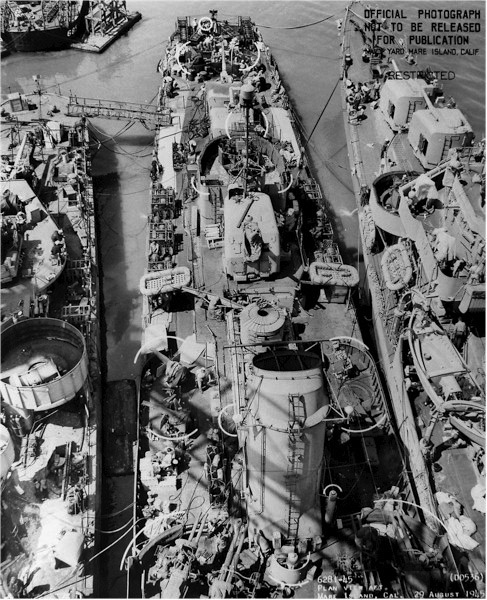
USS Ellet, Owen and Miller at Mare Island, 29 August 1945.
In 1941, USS Lang, Mayrant, Trippe, Rhind, Rowan, Stack, Sterett and Wilson saw the removal of two 533mm TT banks, in exhange of three 12mm.7/90 AA and four 4 DCT (46 DC at all)
By early 1942, USS Benham and Ellet had all their four 12.7mm/90 Browning removed as well as two TT banks in exhange for six single 20mm/70 Oerlikon Mk 4, and four 4 Depht Charge Throwers (44 DC).
They were soon followed by USS Lang, Mayrant, Trippe, Rhind, Rowan, Stack, Sterett, Wilson which had not six but seven Browning .05 cal. kept, in indididua positions, plus the same six 20mm/70 Mk 4 AA guns. It appeared soon that the Brownings were not ideal, although light.
In 1942-1944 the ships saw the addition on their mast and fire director of SC, SG, Mk 12.22 radars. They also received two more single Oerlikon guns and two twin extra 40mm/56 Mk 1.2 Bofors to really beef up their anti-aicraft defence.
By the summer of 1945, USS Lang, Sterett and Wilson received the last upgrade evolution, with four 20mm/70 AA as well as their remaining two 21-in TT banks removed, in exhchange for two twin 40mm/56 Mk 1.2 AA mounts and four twin 20mm/70 Mk 4, not that larger than the original single ones. The added weight was compensated by the removal of the TTs, as by that stage, Kamikaze was the main threat, not rare encounters with IJN surface vessels.
Close to their decommission, USS Mayrant, Trippe and Rhind and the remainder ships had in standard two twin 40mm/60 Mk 1, four single 20/70 Mk 10, but still two quad 533mm TT, but also four DCT (Y-Guns), and two racks (DCR) with 46 depht charges in reserve.
Only DD407 Sterrett and DD408 Wilson missed their TT banks. Their AA was more extensive with four twin (instead of two twin) 40mm/60 Mk 1, four twin 20mm/70 Mk 24 AA (instead of four single) and same ASW armament, radar and sonar suites.
Appearance
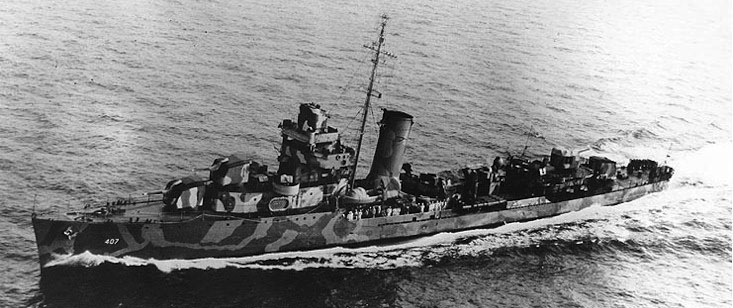
1942 camouflage, Measure xxx
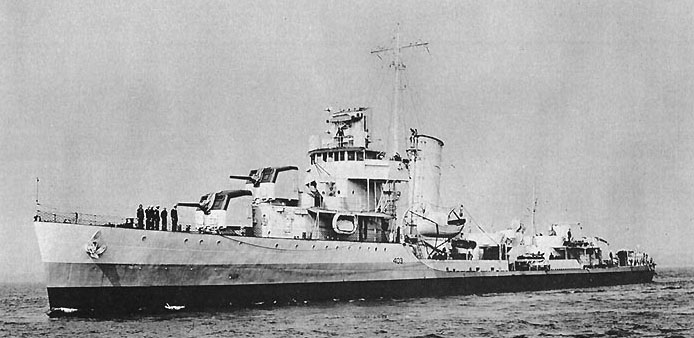
USS Trippe underway off Boston, 23 May 1941, Measure xxx
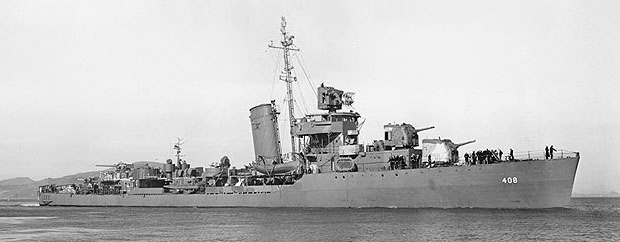
⚙ specifications |
|
| Displacement | 1,656 tons standard, 1,888 tons norma, 2,250 tons FL |
| Dimensions | 340 ft 9 in x 35 ft 6 in x 13 ft 3 in (103.86 x 10.82 x 4.04 m) |
| Propulsion | |
| Speed | 37.9 knots (70.2 km/h; 43.6 mph) |
| Range | 5,390 nmi (9,980 km; 6,200 mi) at 12 knots (22 km/h; 14 mph) |
| Armament | 4× 5-in/35, 4× .50 cal. HMG, 4×4 21-in TTs, 2× DC racks |
| Sensors | Mk33 GFCS, SC radar |
| Crew | 9 officers, 175 enlisted, peacetime. 16 officers, 235 enlisted wartime |
Evaluation
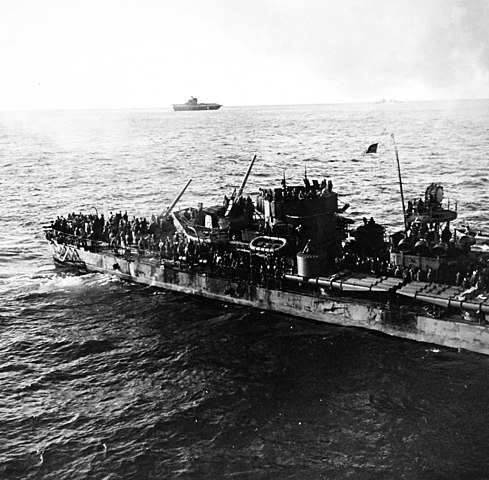
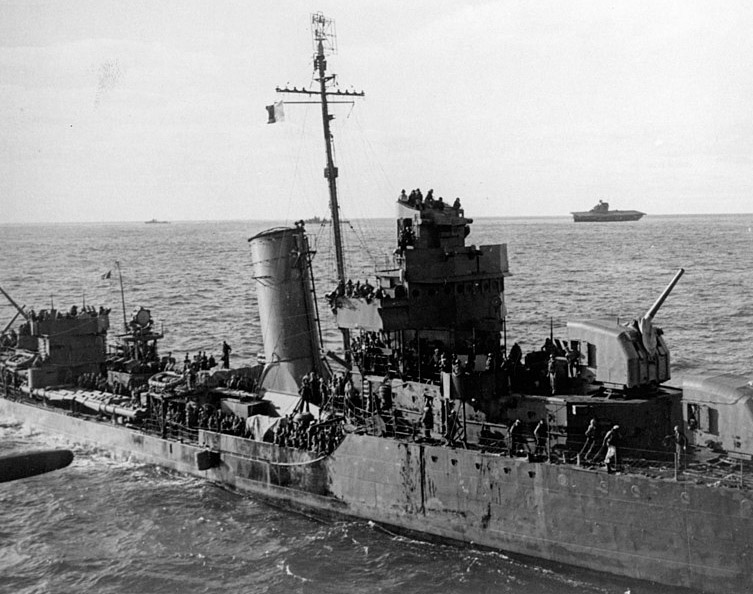
USS Benham with the survivors of USS Yorktown on 4 June 1942 (Conclusion of the Battle of Midway)
This class, except USS Benham and Ellet, served on Neutrality Patrols in the Atlantic, and escort duty in the Atlantic and Mediterranean as Destroyer Squadron 8 (DesRon with USS Wainwright as flagship) from April 1940 to December 1941. Benham and Ellet were at sea in the Pacific on 7 December 1941 with Dunlap and Fanning (Mahan class) as DesDiv 12, DesRon 6, USS Balch being its flagship. Later, this four-ship division escorted the aircraft carrier USS Enterprise during the Doolittle Raid.
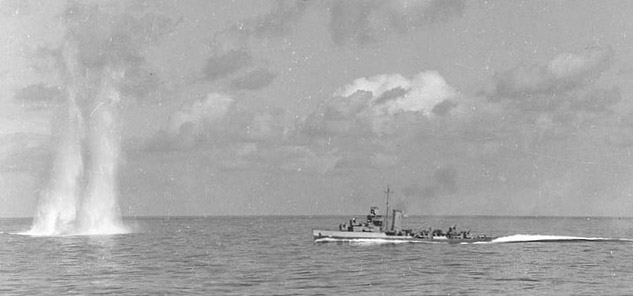
In June 1942, DesDiv 15 (Lang, Stack, Sterett and Wilson) escorted USS Wasp to the Pacific, and DesDiv 16 (Mayrant, Trippe, Rhind, and Rowan) remained in the Atlantic, taking part in Operation Torch on the shores of North Africa, in October-November 1942 and remained in this theater, seeing action in Italy, USS Mayrant being badly damaged by the Luftwaffe off Palermo, Rowan being sunk by a German E-boat off Salerno.
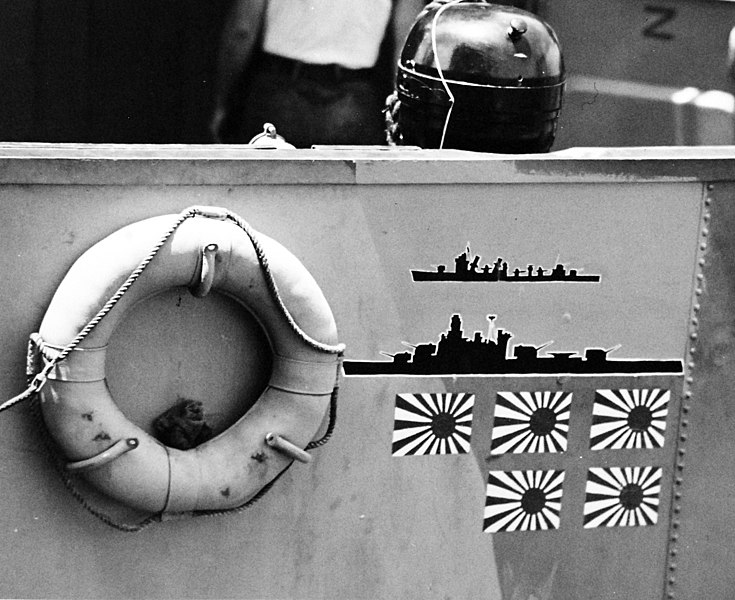
Trophy flags aboard USS Sterett (DD-407) after First Naval Battle of Guadalcanal 13 November 1942
The remaining six Pacific destroyers of the class saw actoin in the Solomon Islands (Ellet scuttled by torpedoes the crippled Australian heavy cruiser HMAS Canberra after the Battle of Savo Island). They were also present at the 1st Naval Battle of Guadalcanal, Sterett being badly damaged and USS Benham sunk. Lang, Sterett, and Stack were in “DesDiv A-2” at the Battle of Vella Gulf in 1943. The five remaining DDs saw action during the Marshalls and Marianas campaigns, were reassigned as DesDiv 4 (DesRon 2) seeing action during the campaign of Leyte and ending with another battle star well earned at Okinawa or Iwo Jima. In April 1945, Sterett and Wilson while on radar picket duty were damaged by Kamiukaze but survived. Sterett’s repaired ended with the war. Apart Sterett, Ellet, and Lang scrapped in 1947 the others ended in Operation Crossroads atomic bomb tests. Highly contaminated, they were scuttled off Kwajalein in 1948, still there today, but certainly not a place for any diver.
USS Sterett was the most decorated of the entire class, earning 12 battle stars, plus a United States Presidential Unit Citation for the Battle of Guadalcanal and Vella Gulf, as well as the Philippine Republic Presidential Unit Citation. Those which served in the Atlantic were less favoured, awards-wise.
Read More
Books
Bauer, K. Jack; Roberts, Stephen S. (1991). Register of Ships of the U.S. Navy, 1775-1990. Greenwood Press.
Friedman, Norman (2004). US Destroyers: An Illustrated Design History (Revised ed.). NIP
Gardiner, Robert; Chesneau, Roger (1980). Conway’s All the World’s Fighting Ships 1922-1946.
Silverstone, Paul H. (1965). U.S. Warships of World War II. London: Ian Allan Ltd.
Links
Benham-class_destroyer wiki
on destroyerhistory.org
on destroyersonline.com/
on .destroyers.org/
on destroyerhistory.org/
destroyerhistory.org
pdf benham_GIBook.pdf
on navsource.org/
on navypedia.org
on the pacific war
Model Kits
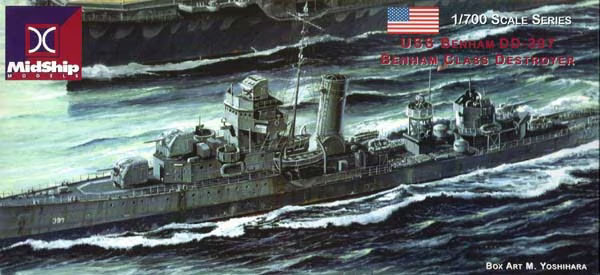
The Benham class on scalemates
Many models at many scales: Ex. USS Stack MidShip Models 1:700, USS Benham MidShip Models 1:700, USS Sterett Kraken Hobbies 1:700 and Kobo hiryu 1:700, USS Wilson Model Monkey 1:350 and 1:700, USS Benham The Scale Shipyard 1:48 and 1:96 among others.
3D
The Benhams in action
 Benham DD-397
Benham DD-397
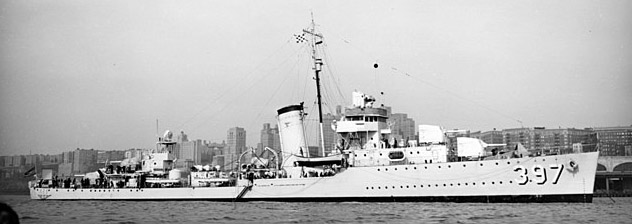
Benham 1939 DD-397
USS Benham, built at Federal Shipbuilding, launched 16 April 1938, comp. 2 February 1939 was commissioned the same day with Lieutenant Commander T. F. Darden in command.
Assigned to the Atlantic Fleet, she patrolled off Newfoundland in 1939 and to the Gulf of Mexico. In 1940 she was ordered to the Pacific, arriving in Pearl Harbor 14 April 1940. She became an escort for USS Enterprise, delivering Marine planes to Midway on 28 November-8 December 1941, missing the Pearl Harbor attack. She went on escorting Enterprise and Saratoga task forces with TF 16 during the Doolittle raid 8- 25 April 1942. She still was with TF 16 at the Battle of Midway, rescuing 720 survivors from USS Yorktown and 188 from USS Hammann. She took part in the landings on Guadalcanal and Tulagi, on 7-9 August 1942 and was present at the Battle of the Eastern Solomons, 23-25 August.
She joined TF 64 on 15 October for the Guadalcanal cover and on 14–15 November, was at the Naval Battle of Guadalcanal. At 00:38 on 15 November she took a “long lance” torpedo at her bow which severed her forecastle, forward of the bridge. Her bulkhad kept her afloat, still capable of moving but very slow but at 16:37, since the area was still “red hot”, with no port to be repaired, it was decided abandon ship. USS Gwin picked up survivors, and her at 19:38 by gunfire. For her short pacific service she would be awarded five battle stars.
 Ellet DD-398
Ellet DD-398
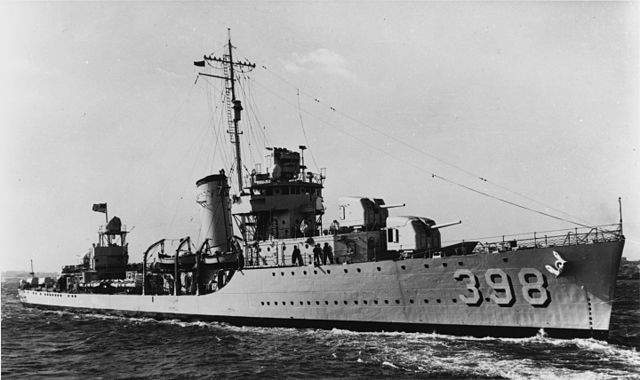
USS Ellet was ordered on 3 December 1936, launched on 11 June 1938, completed on 17 February 1939, commissioned that day and between September and October 1939 she patrolled off the Grand Banks, then joined DesDiv 18 in Galveston (West Gulf Patrol). She was moved to the Pacific, San Diego after 26 February 1940, for maneuvers between there and Hawaii. The summer of 1941 saw her based in Pearl Harbor. In October she carried an Army survey expedition from Christmas Island to Honolulu. On 7 December 1941 she was returning from reinforcing Wake Island with TF 8. She stayed wit this unit until the end of December. She escortted a convoy to the west coast and a troop convoy back to Christmas Island by February 1942.
In April 1942 still with TF 16 she was part of the Doolittle Raid. Later she took part in the Battle of the Coral Sea. She returned to Pearl Harbor and accompanied TF 16 on 28 May 1942 to join TF 17, taking part in the Battle of Midway. USS Ellet was back to Pearl Harbor on 13 June, prepared for invading the Solomons.
She arrived off Guadalcanal on 7 August 1942. On 9 August she rescued the crew of the sunken USS Quincy and Astoria after the Battle of Savo Island. She teamed with USS Selfridge (DD-357) in sinking the crippled HMAS Canberra. While en route to Nouméa, New Caledonia, USS Ellet was detached 12 August to screen USS Enterprise (CV-6) covering a reinforcement missioned in the Solomons. She was based in Espiritu Santo and patrolled to the Solomons with TF 16 from November 1942 until May 1943. She also took part of the battle of Tulagi before an overhaul at home by September 1943.
By late January 1944, she was back to participate in the Invasion of the Marshalls. She was also detached to New Guinea, of the landings at Hollandia in April 1944. Assigned to the 5th Fleet she took part in the invasion of the Marianas, being present during the attack on the Bonins, Saipan and Guam.
Sent at Ulithi by 13 October, she scouted Ngulu Atoll for a proposed secondary fleet anchorage. USS Montgomery (DM-17) struck a mine and was rescued by USS Ellet, with pumps. The ship was saved and towed to Ulithi lagoon to be repaired.
She was part of the Marianas Patrol, bombarded Iwo Jima, and returned to Guam and Saipan to escorted more convoys until July 1945. Sent to Mare Island she was decommissioned on 29 October 1945, and sold 1 August 1947. She earned 10 battle stars.
 Lang DD-399
Lang DD-399
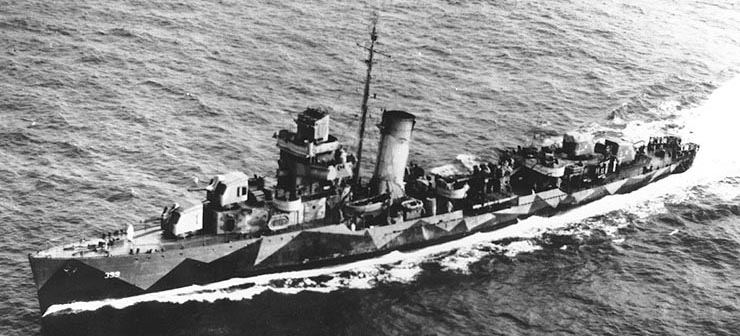
USS Lang was laid down on 5 April 1937, launched on 28 August 1938 and commissioned 30 March 1939.
Departing New York on 12 August as part of the President’s passage to Campobello in Newfoundland and Nova Scotia she was detached to Newport and left in November, for Rhode Island, and then Galveston and the Gulf Patrol. Transferred to the Pacific, San Diego (18 March 1940) she headed for Pearl Harbor (2 April) for fleet training. By June 1941 she returned to the Caribbean for carrier and ASW training, aircraft guard forUSS Yorktown and Ranger off Maine and Bermuda.
In 1942 in Port Royal, Nova Scotia she patrolled with the Royal Navy, British West Indies, rescued the crew of SS Empire Wildebeeste. From Casco Bay she escortedg TF 39 which (USS Wasp) to Scapa Flow and she integrated “Force W”, operating between British ports and the Mediterranean, notably on the dangerous Malta route, Operations Calendar and Bowery. Back in Norfolk on 28 May, then San Diego she integrated DesDiv 15 (TF 18) and in July joined exercizes of Tonga and then the Guadalcanal-Tulagi landings, screening USS Wasp. She operated in the New Hebrides, and in Solomons by 22-24 January 1943 shelled Japanese positions near Kokumbona. In July she escorted APDs in Kula Gulf (New Georgia landings). Next she headed for Purvis Bay (Nggela Islands) for the landings at Onaiavisi, New Georgia, and claimed one aircraft shot down.
USS Lang intercepted enemy forces in Vella Gulf (“Tokyo Express”) on 6-7 August in a firce night battle when they sunk IJN Kawakaze, Arashi and Hagikaze en route with troops to Kolombangara. Later she drove off troop transports. She was part of TF 50 for the invasion of the Gilberts in November, bombarded Nauru (9 December) Roi and Namur.
She was with TF 58 at Kwajalein, took part in the Marianas, returning for supply and rest at Tulagi.
She cover a minelaying operation at Wewak, New Guinea on 31 August 1944, shelling shore positions. She escorted a convoy to Morotai (16 September-3 October) and on 8 October towed the torpedoed USS Shelton (DE-407), which sank. On 10 October she left Hollandia for Leyte Gulf operations, escaping kamikaze attacks. From Manus with TF 78 she entered the Lingayen Gulf, claiming a Kamikaze.
Back in Leyte gulf on 16 January 1945 she escorted a convoy to Lingayen and was later prepared for the Okinawa assault.
On 27 March she became flagship for ComDesDiv 4, escorting TF 53 to Okinawa. She claimed another Kamikaze on 12-29 April, and on 29 April-17 May screened three escort carriers for air support and other ships until 11 June. She was back in San Francisco, departing on 3 July for an overhaul, and was decommissioned on 16 October 1945, sold on 20 December, scrapped on 31 October 1947. She was awarded 11 battle stars.
 Mayrant DD-402
Mayrant DD-402

USS Mayrant was built at the Boston Navy Yard, laid down on 15 April 1937, launched 14 May 1938, commissioned on 13 September 1939. After shakedown and training period she escorted the president’s ship on a tour of east coast defenses and later the newly acquired bases after the “destroyers for bases” agreement.
The spring of 1941 saw her engaged in neutrality patrols to and from Iceland, operating off Newfoundland and was part of the escort during the Atlantic Charter Conference, escorting HMS Prince of Wales to GB.
By late October she escorted a convoy from Halifax to Cape Town and more British and Canadian troops to South Africa, back home in January 1942, but making 5 more months on the North Atlantic convoy route, to Scapa Flow. She was part in the hunt for Tirpitz in the Denmark Strait and made the “suicide run” to Murmansk. Back to the east coast (July) after training she returned to convoy escort missions to north Africa (Operation Torch, Naval Battle of Casablanca). Later she was based in Mers-el Kebir, and patrolled from Oran to Bizerte. By July, and while off Palermo on 26 July she was attacked by Luftwaffe Stukas.
She took a very very close miss near her port bow, the blast extensive damage. All her flank ruptired and her machinery was flooded. She was towed to Palermo (5 dead, 18 wounded) for quick repairs. Her executive officer at the time was no less than Franklin Delano Roosevelt, Jr., later awarded the Silver Star for his action in saving the ship and the crew performed very well. In port she had mattresses were stuffed into the holes and while there, her secondary guns defended Palermo from other attacks. On 9 August, she was towed to Malta for temporary repairs until 14 November. She was then sent to Charleston for final repairs.
This was over on 15 May 1944 and she operated on the east coast, escorting new cruisers and aircraft carriers during their shakedown cruises as well as coastal convoys and still two convoys to the Mediterranean. On 5 April 1945, she rescued the crew of the SS Atlantic States torpedoed off Cape Cod in heavy weather, taking her in tow. She was reassigned to the Pacific Fleet via arrived Pearl Harbor (21 May 1945) and on 2 June she sailed for Ulithi and escorted convoys to Iwo Jima, Okinawa, and Saipan. From 15 to 31 August, she was performing air-sea rescue missions in the Marshalls and Marianas. Back in San Diego on 30 September 1945, she was designated for Operation Crossroads, sunk 4 April 1948 off Kwajalein. She was awarded 3 battle stars.
 Trippe DD-403
Trippe DD-403
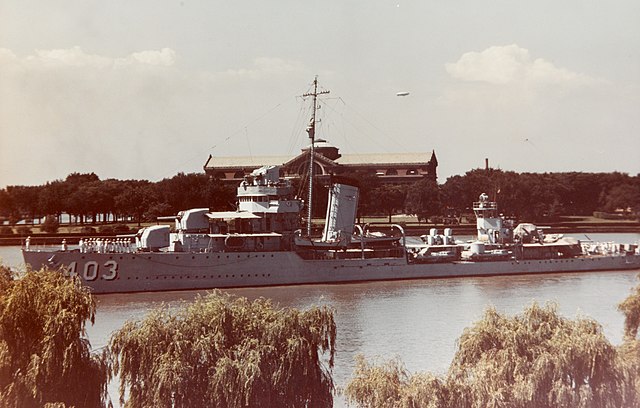
USS Trippe was laid down on 15 April 1937 at Boston NyD, launched on 14 May 1938, commissioned on 1 November 1939 and in January 1940 trained to the Gulf of Mexico making (shakedown), fixed at Boston in March, joined the Caribbean Neutrality Patrol in June-July. She notably escorted USS Tuscaloosa, with President Franklin Roosevelt on board. After a refit at Philadelphia and by 21 March a two-month overhaul at Boston she resumed Neutrality Patrols to mid-Atlantic. On 11 June, screened USS Texas when the latter was nearly torpedoed by an U-boat. HP Newport, she went on patrolling, screening also USS Ranger, Vincennes, and Quincy.
For 10 months, she escorted convoys in the northwestern Atlantic, off Newfoundland, and to Iceland or even Londonderry (Northern Ireland). By October 1942, she joined USS Massachusetts and took part in the invasion of French North Africa, making a Casablanca-New York trip on 7 February 1943. Next, one to Oran and Bizerte before taking part in the Allied landings on Sicily. She was at Gela and Palermo, attacked by the Luftwaffe, claimed one Stuka.
On 4 August 1943 she screened Savannah and used gunfire on axis position along Patton’s route notably on Terranova. Sehe joined USS Philadelphia at Sant Agato di Militello and Spadafora. She accompanied PT boats during the seizure of Lipari and Stromboli. On 20 August, Trippe and Wainwright shelled a railroad bridge at Fiume Petrace. Sge escoted ships back to Bizerte and Oran.
Next she was at Salerno on 9 September 1943, protecting the area from the Luftwaffe and supporting troops.
She made several escorted between Salerno and Oran then Naples to Oran, attacking U-371 which escaped.
Convoy operations in the western Mediterranean went on until backto Gibraltar with USS Brooklyn She met USS Iowa off Casablanca, hosting President Roosevelt for the conferences at Cairo and Tehran, escorted from Gibraltar to Oran and Casablanca.
On 16 December USS Trippe with Edison and Woolsey made radar contact with U-73, surfaced, at night, and under searchlights, she was rapidly sunk by gunfire. In Jan. 1944, she was at Palermo and setn to support the landings at Anzio, screening USS Brooklyn with USS Edison, and put up gunnery support, battling the Luftwaffe. She returned to Oran, Casablanca, joining USS Card’s hunter-killer group. After upkeep at New York she returned ti hunter-killer operations in Casco Bay. In May 1944 she escorted USS Hancock for her shakedown and USS Ticonderga, Shangri La, escorting another convoy to Oran.
After an overhaul she was sent to the Pacific, San Diego, Pearl Harbor (16 May 1945) and escorted convoys between various islands in the Central Pacific (Iwo Jima, Saipan, Ulithi, Okinawa) until 15 August. She stayed in the Marianas and Bonin Islands, Saipan, Guam and back home but on 16 January 1946, ended in Operation Crossroads. On 3 February 1948 she was towed off Kwajalein to be sank. She earned six battle stars.
 Rhind DD-404
Rhind DD-404
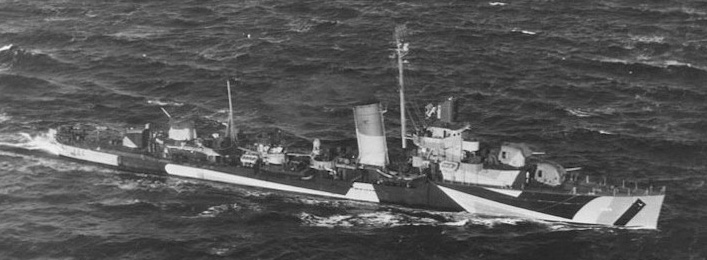
USS Rhind was built at Philadelphia NyD (LD 22 September 1937, LC 28 July 1938, Comp. 10 November 1939). After her shakedown to Brazil, postshakedown availability, in July to December 1940 she trained in the Caribbean and off Martinique, watching at the Vichy fleet there. She became a carrier escort in the first half of 1941, joined TF 1 in June and was in neutrality patrols in the North Atlantic. In August she escorted USS Augusta (CA-31) carrying President Franklin D. Roosevelt to Newfoundland Atlantic Charter conference and later HMS Prince of Wales to Iceland. In October she escorted USS Yorktown (CV-5) to Halifax and joined an Halifax-Cape Town convoy escort. She escorted USS Ranger (CV-4) to Trinidad in December.
By February 1942 she was assigned to Icelandic convoys but also coastal convoys (Panama-New York), attacking an The U-boat. She escorted AT-15 to Iceland, hoined TF 99 for 3 months with the Home Fleet and to Murmansk and Archangel. By July 1942 she was back in the US and later assigned the North African landings (Operation Torch), Screening USS Massachusetts (BB-59) which duelled with Jean Bart during the Battle of Casablanca. She repelled Vichy ships which sortied and silenced shore batteries. In 1943 she guarded convoys to North Africa-New York and back (convoy GUS-6 and others).
On 10 July she took part in the invasion of Sicily, patrolled off Gela, Palermo, assisted the badly damaged USS Mayrant (DD-402) and battled Junkers 88s. Near Messina she sank an E-boat and performed shore bombardments.
After Oran, she protected a convoy to Bizerte in September and was prepared for invasion at Salerno, arriving on the 9th, fighting continuously the Luftwaffe. She was sent back to New York to escort more convoys, then the Caribbean and in July 1944 escorted a convoy to Naples, then in September, November, December, screened USS Shangri-La (CV-38) on her shakedown.
Her Carribean service ended in March 1945 and after a last run to Britain until 18 April she was sent to the Pacific Theater in 5 May, Pearl Harbor, then screen USS Lexington (CV-16), Hancock (CV-19), and Cowpens (CVL-25) in June for a raid on Wake Island. She moved to Leyte in June, Ulithi, and Okinawa; Saipan in August for a last convoy to Okinawa. In Septebmer she hosted at Pagan Island Commodore Vernon F. Grant accepting the surrender of the local Japanese garrison. She patrolled between Marcus Island, Iwo Jima, Saipan and the Marianas until mid-December and back to San Diego, stripped, sent to Pearl Harborfor disposal, blasted at Operation Crossroads, moved to Kwajalein and sunk on 22 March 1948. She earned 4 battle stars.
 Rowan DD-405
Rowan DD-405
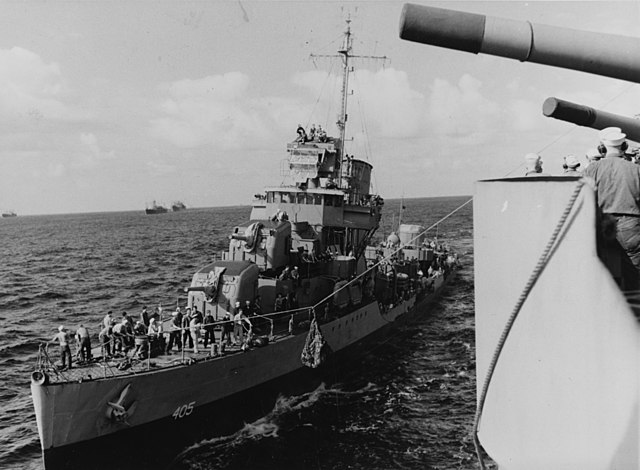
USS Rowan was built at Norfolk Navy Yard (LD 25 June 1937, launch 5 May 1938, Comp. 23 September 1939) and after her shakedown in the Caribbean departed Norfolk on 17 May 1940 for San Diego but returned in 1941 for Atlantic Neutrality Patrols in the spring and summer from Newfoundland to the Caribbean. By November, she escorted Convoy WS-12X from Halifax, Nova Scotia to Cape Town.
By January 1942, she escorted another from Halifax to mid-ocean point. She was also Iceland with TF 99 and between Hvalfjordur and Scapa Flow.
She escorted convoys PQ-16 and QP-12 and the first convoy to Russia.
In June she left Scapa Flow for Iceland for PQ 17 and QP-13 while the Germans launched operation “Rösselsprung” from occupied Norway. She battled the Luftwaffe, shooting down one attacker and proceting the convoy (No ships lost). Not the same story for PQ 17, only 11 arrived in Russia.
USS Rowan screened cruisers to Iceland until her unit, DesDiv 16, was relieved and she was Overhauled at Boston. She escorted convoys to Panama, trained off Maine and in October 1942 joined TF 34 for Operation Torch. She arrived off Fedhala, taking part in the Battle of Casablanca, fought Vichy ships attempting sally forth. After a trip back to the US she returned in December 1942-April 1943 for more escorts to Casablanca. On March 16 she scuttled Benjamin Harrison with gunfire, torpedoed. In May she joined TF 80 at Mers-el-Kebir for ASW patrols and escorts.
She took part in 10 July to the invasion of Sicily, Gela and Palermo area. One 26 July, shore bombarded positions between Cefalù and Stefano di Camastra. Later she was prepared for operations at Salerno and on 9 September, entered the Gulf with the Southern Attack Force, Landings at Paestum. On the 10th while back to Oran, Shortly after midnight, she was attacked by undetected German E-boats, she fired on them until they retreated, but they came back in and closed at 3,000 yards to fire torpedoes. USS Rowan dodged them but the range fell at 2,000 yards, and she was hit by a torpedo in a pincer attack, sinking in less than a minute with 202 (out of 273) crewmembers. She earned 5 battle stars.
 Stack DD-406
Stack DD-406
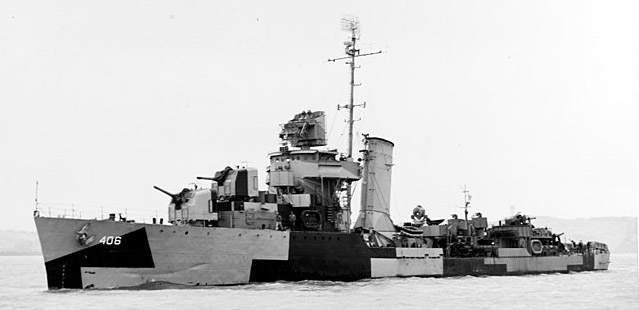
USS Stack was laid down on 25 June 1937 at Norfolk Navy Yard, launched on 5 May 1938, commissioned on 20 November 1939, (Lt. Cdr. Isaiah Olch). After shakedown down to Rio de Janeiro and post fixes, she joined the Pacific fleet at Pearl Harbor, operating until June 1941. After an overhault at Piladelphia NyD she was in Neutrality Patrol until 22 December. She moved to Maine, NS Argentina screening USS Long Island and Philadelphia escorting various convoy notably for the invasion of Iceland. She operated with TF 15 and attacked, damaged U-132.
On 17 March in dense fog she collided with Wasp, repaired in Philadelphia.
In June she joined TF 37 (Wasp, Quincy, San Juan, 4 DDs) to San Diego, renamed TF 18, and proceeded to Tongatapu Island, later taking part in the invasion of Guadalcanal. She was part of DesRon 12, sent in independent escort and patrol. After overhaul at Mare Island in February she was sent to the New Hebrides, Efate, joined TF 31 and on 6-7 August was at the Battle of Vella Gulf wit TG 31.2, making radar contact at 19,000 yards of the Japanese, part of the interception force that sanke Japanese destroyers Arashi, Hagikaze, and Kawakaze.
Later she joined TF 38 to Rabaul and repelled air attacks, having 2 and more probable kills. She operated with TG 50.4 during the landings on Tarawa and Makin (Gilberts) and repelled another air attack on 20 November, then shore bombarded Nauru Island on 8 December 1943. In Jan-February 1944 she was at Kwajalein and Majuro, Marshalls, Bombardment Support Group on Roi-Namur. Later the raid on Truk and Jaluit Atoll. After a new US overhaul she was back at Milne Bay on 15 July with TG 76.7. She operated off Wewak (New Guinea), shelled Kairiru Island, was at Morotai, in September, and with TG 78.4 entered Leyte Gulf on 17 October, staying at Dinagat Island area. She supported minesweeping operations off Pinaon Island.
With TG 78.5 she was at Sansapor (New Guinea) by 30 December 1944 and the landing at Luzon, later escorting convoys between Leyte and Lingayen.
On 8 February 1945 she resplenished/rested in the Solomon Islands. She was in the Ryūkyūs with TF 53 and Okinawa on 1 April. Then Saipan, Ulithi joining TU 94.18.12 in April and back to Okinawa, Hagushi, Zampa Misaki, Sakashima Group until early June.
She screened USS Louisville back to Pearl Harbor and having boiler trouble they were changed in Pearl Harbor until late July. Back to Eniwetok, Saipan, Okinawa, and Guam she learned about the end of the war. She carried General Leo D. Hermle (USMC) and Navy/USMC staff officers for a preliminary conference of surrender on 30 August. She roamed Guam, Iwo Jima, Haha Jima with the Occupation Forces and in pearl by mid-December, then the west coast, San Diego and back to Pearl Harbor or disposal, Operation Crossroads, sunk by gunfire near Kwajalein on 24 April 1948. She earned 12 battle stars.
 Sterett DD-407
Sterett DD-407

USS Sterett was built in Charleston Navy Yard, laid down on 2 December 1936 launched 27 October 1938, commissioned on 15 August 1939. She left South Carolina on 28 October 1939 with the destroyers USS Mustin and Hughes for their shakedown cruiser in the Gulf of Mexico and back to Charleston on 20 December for post-shakedown overhaul and trials. By 4 May 1940 she was assigned to DesDiv 15, and joined USS Hammann at Guantanamo Bay heading for San Diego via Panama, arriving on 23 May. She screen USS Enterprise, sailed for Pearl Harbor on 24 June, staying there for 10 months. She screen USS Mississippi on 14 May 1941 back to Norfolk. She then screen USS Long Island to Bermuda and spent the rest in neutrality patrols with USS Wasp (like several DDs of her class).
In December she was off Bermuda watching any move fromr Vichy French ships in Martinique. She went on in Jan-Feb. 1942 her patrols of the eastern seaboard, notably to NS Argentia, TF 15 to Iceland. She notably escorted from NyC RMS Queen Mary and joined Wasp assigned with the British Home Fleet at Scapa Flow. She was part of the first convoy to Malta, with another on 29 April to 15 May. Back to Norfolk on 27 May 1942 she was sent to San Diego (19 June) and joined TF 18 in the Fiji Islands, joined RADM Richmond K. Turner’s Expeditionary Force in the Solomon Islands and Bismarck Archipelago. She was part of the CV core (Saratoga, Enterprise, Wasp) in August 1942 covering the assault of the 1st Marine Division at Guadalcanal. She later screen USS Long Island at Guadalcanal, but was back to USS Wasp until 10 September 1942. She escorted ships to Espiritu Santo and was in New Caledonia and back to Guadalcanal, bombarding Henderson Field.
She took part in the Naval Battle of Guadalcanal on 12 November, shot down four torpedo bombers and dodging three torpedoes that day, and operated with RADM Daniel J. Callaghan cruiser force to intercep VADM Hiroaki Abe’s force. On the 13th USS Sterett was found close to IJN Hiei, launching four torpedoes she firing on her superstructure with her main batteri with HE shells, scoring two torpedo “hits” (duds). She also fired on and launched two torpedoes on en escorting destroyer, sending her down to “Ironbottom Sound”. However USS Sterett took eleven direct hits and at 02:30, always off Savo Island, she withdrawn and was back in formation close to USS San Francisco. She later attacked by DCs a sound contact, perhaps the sub that sank USS Juneau. After emergency repairs at Espiritu Santo on 18 November she was in New Caledonia, Pearl Harbour, and San Francisco’s Mare Island for two months repairs. Back to Espiritu Santo on 3 March she escorted convoys in the Solomons-Bismarcks area.
On 6 August 1943, she was part in an attack of six-destroyer (Frederick Moosbrugger) to intercept four IJN destroyers delivering troops and supplies to Kolombangara, Radar picked them, and caught them steaming at 30 knots, launching their torpedoes and firing, hitting three which sank. Only IJN Shigure survived. By August-September she patrols in the Solomons. She was Sydney with USS Cleveland to sail back to Espiritu Santo with a convoy. She took part in the attack on Bougainville, Nauru Island, escorted USS Alabama to Pearl Harbor, Ellice Islands (Funafuti) in January 1944. and USS Bunker Hill, Monterey.
Until 7 March 1944 she took part in the Marianas- Marshalls campaign (Roi, Namur, Truk, Tinian, Saipan). In the New Hebrides she was with the Emirau invasion force, Purvis Bay, Florida Island, Efate.
After a new overhaul at Puget Sound she was back to Oahu and sortied with TG 12.1 for the Marshalls, Majuro, then TF 58 (6 June 1944) during the invasion of the Marianas, Saipan, Iwo Jima, Guam, Rota. Until 7 July, she patrolled Guam-Rota, bombarded Guam, accompanied assaults on Yap, Palau, and Ulithi. She had another overhaul at Puget Sound and on 13 October 1944 was back in Hawaiia, joining TU 16.8.5 on 19 November, went to Manus and Leyte Gulf in convoy duty, Mindoro and entered San Pedro Bay after firce Camikaze attacks. She escorted convoys to and from the Solomons.
By 1 April 1945, she was off Okinawa as radar picket ship, assisting USS Bennett hit by a kamikaze but on the 4th, at picket station No. 4 (northeast of Okinawa) on of 5 Kamikazes hit her starboard side at her waterline. Loosing all electrical power, she lost steering control and power for all her guns as her communications. Fires were under control, and utlimately steering reestablished, emergency communication too so she moved off to Kerama Retto protected by USS Jeffers. She screened TU 53.7.1 to Ulithi for more repaired and escorted by USS Rail to Pearl Harbor, then Bremerton, Washington, exited in August 1945 but staying on West Coast, learning about the end of the war. On 21-28 August she was back to Pearl Harbor for shore bombardment/AA gunnery adn screened USS Mississippi, North Carolina and Enterprise. She was back to New York City on 17 October, decommissioned on 2 November 1945, stricken on 25 February 1947, sold on 10 August and BU. Probably the most decorated ship of the Behnam class, USS Sterett won 12 battle stars and two Presidential Unit Citation for the Battle of Guadalcanal and the Vella Gulf, plus the Philippine Republic Presidential Unit Citation.
 Wilson DD-408
Wilson DD-408

USS Wilson was laid down at Puget Sound Navy Yard on 22 March 1937, launched 12 April 1939, completed on 5 July 1939, fitted out at Bremerton, Washington and after operating on the west coast sown to South America until April 1940, she took part at Hawaii in Fleet Problem XXI. By June 1941 she was in Atlantic neutrality patrols until first months of 1942. By March–May 1942 she was on the convoy route to Iceland and the British Isles.
She was recalled to the Pacific with USS Wasp’s task group, reaching the south Pacific in July 1942 and taking part in the landings at Guadalcanal and Tulagi. On 9 August, she engaged Japanese cruisers during the Battle of Savo Island, and recued survivors from Quincy, Astoria and Vincennes.
After a west coast overhaul, she was back to Guadalcanal in January 1943, took part in the the landings on the Russell Islands, shelled Japanese position in New Georgia, escorted convoys to and from the Solomon Islands. By November 1943 she screened the carriers fleet fir the raids on Rabaul and Nauru, and took part in the Marshall and Carolines campaign in Jan-February 1944. By June-July 1944, she was part of TF 38 during the Marianas Campaign and Battle of the Philippine Sea, and bombarded Guam.
She had a new overhaul in August–October 1944, and by December 1944 escorted a convoy to Mindoro amidst fierce Kamikaze attacks. She took part in the Lingayen Gulf invasion. On 16 April 1945, she was at Okinawa when hit by a kamikaze but survived (five dead, many wounded), having an unexploded bomb in her aft section. Repaired in drydock she resume her escort work off Okinawa until June 1944, then moved to Saipan until 15 August.
She stayed on the Pacific for occupation duty until December 1945 before returning to the west coast. Instead of beind sold for BU, she was sent in May to be part in Operation Crossroads. She was towed from Bikini (decommissioned in August 1946) to Kwajalein and sunk in deep water, highly irradiated on 8 March 1948. With 11 battle stars USS Wilson was one of the most decorated ship of her class.

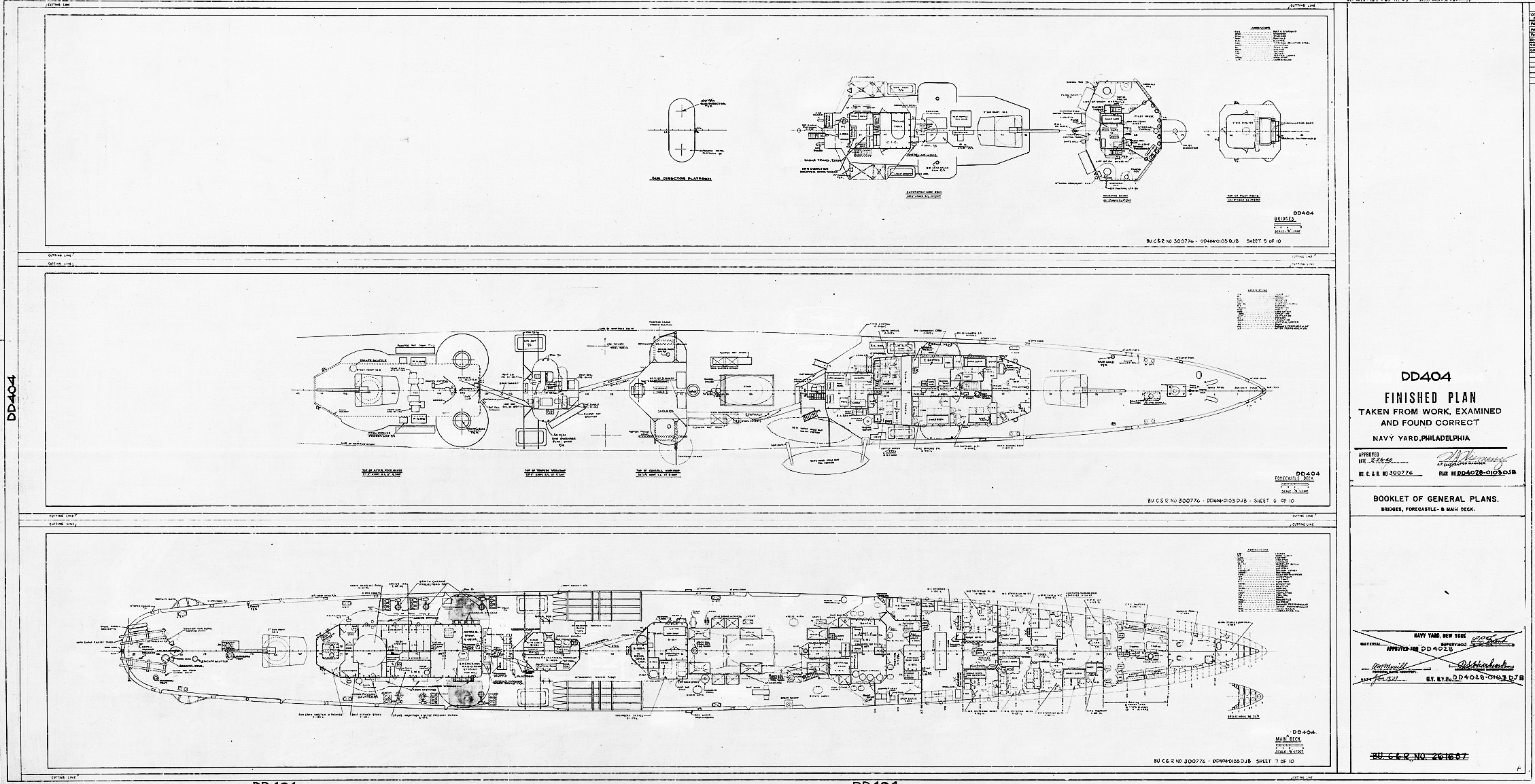


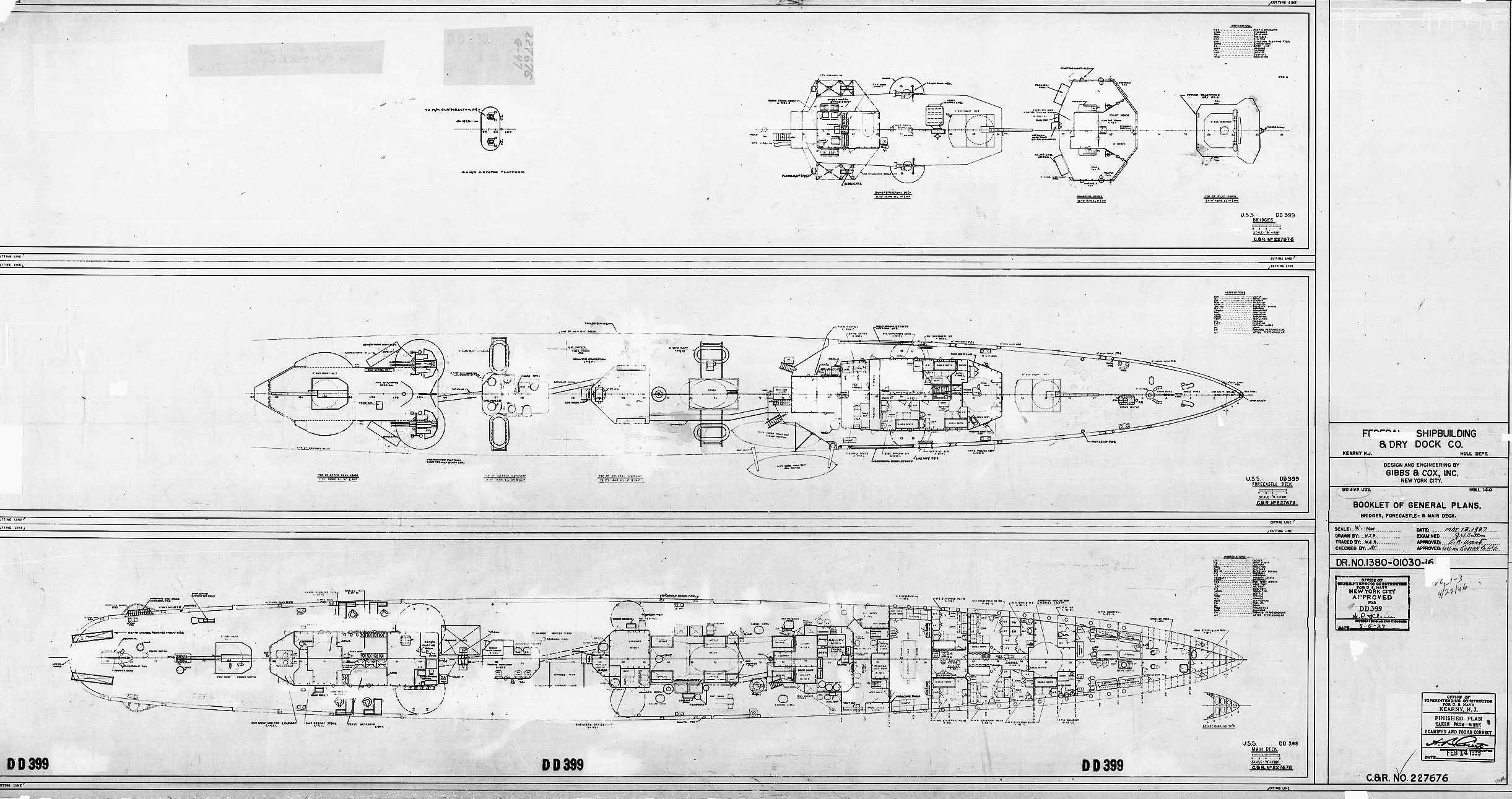
 Latest Facebook Entry -
Latest Facebook Entry -  X(Tweeter) Naval Encyclopedia's deck archive
X(Tweeter) Naval Encyclopedia's deck archive Instagram (@navalencyc)
Instagram (@navalencyc)





 French Navy
French Navy Royal Navy
Royal Navy Russian Navy
Russian Navy Armada Espanola
Armada Espanola Austrian Navy
Austrian Navy K.u.K. Kriegsmarine
K.u.K. Kriegsmarine Dansk Marine
Dansk Marine Nautiko Hellenon
Nautiko Hellenon Koninklije Marine 1870
Koninklije Marine 1870 Marinha do Brasil
Marinha do Brasil Osmanlı Donanması
Osmanlı Donanması Marina Do Peru
Marina Do Peru Marinha do Portugal
Marinha do Portugal Regia Marina 1870
Regia Marina 1870 Nihhon Kaigun 1870
Nihhon Kaigun 1870 Preußische Marine 1870
Preußische Marine 1870 Russkiy Flot 1870
Russkiy Flot 1870 Svenska marinen
Svenska marinen Søværnet
Søværnet Union Navy
Union Navy Confederate Navy
Confederate Navy Armada de Argentina
Armada de Argentina Imperial Chinese Navy
Imperial Chinese Navy Marinha do Portugal
Marinha do Portugal Mexico
Mexico Kaiserliche Marine
Kaiserliche Marine 1898 US Navy
1898 US Navy Sovietskiy Flot
Sovietskiy Flot Royal Canadian Navy
Royal Canadian Navy Royal Australian Navy
Royal Australian Navy RNZN Fleet
RNZN Fleet Chinese Navy 1937
Chinese Navy 1937 Kriegsmarine
Kriegsmarine Chilean Navy
Chilean Navy Danish Navy
Danish Navy Finnish Navy
Finnish Navy Hellenic Navy
Hellenic Navy Polish Navy
Polish Navy Romanian Navy
Romanian Navy Turkish Navy
Turkish Navy Royal Yugoslav Navy
Royal Yugoslav Navy Royal Thai Navy
Royal Thai Navy Minor Navies
Minor Navies Albania
Albania Austria
Austria Belgium
Belgium Columbia
Columbia Costa Rica
Costa Rica Cuba
Cuba Czechoslovakia
Czechoslovakia Dominican Republic
Dominican Republic Haiti
Haiti Hungary
Hungary Honduras
Honduras Estonia
Estonia Iceland
Iceland Eire
Eire Equador
Equador Iran
Iran Iraq
Iraq Latvia
Latvia Liberia
Liberia Lithuania
Lithuania Mandchukuo
Mandchukuo Morocco
Morocco Nicaragua
Nicaragua Persia
Persia San Salvador
San Salvador Sarawak
Sarawak Uruguay
Uruguay Venezuela
Venezuela Zanzibar
Zanzibar Warsaw Pact Navies
Warsaw Pact Navies Bulgaria
Bulgaria Hungary
Hungary

 Bundesmarine
Bundesmarine Dutch Navy
Dutch Navy Hellenic Navy
Hellenic Navy Marina Militare
Marina Militare Yugoslav Navy
Yugoslav Navy Chinese Navy
Chinese Navy Indian Navy
Indian Navy Indonesian Navy
Indonesian Navy JMSDF
JMSDF North Korean Navy
North Korean Navy Pakistani Navy
Pakistani Navy Philippines Navy
Philippines Navy ROKN
ROKN Rep. of Singapore Navy
Rep. of Singapore Navy Taiwanese Navy
Taiwanese Navy IDF Navy
IDF Navy Saudi Navy
Saudi Navy Royal New Zealand Navy
Royal New Zealand Navy Egyptian Navy
Egyptian Navy South African Navy
South African Navy






























 Ukrainian Navy
Ukrainian Navy dbodesign
dbodesign